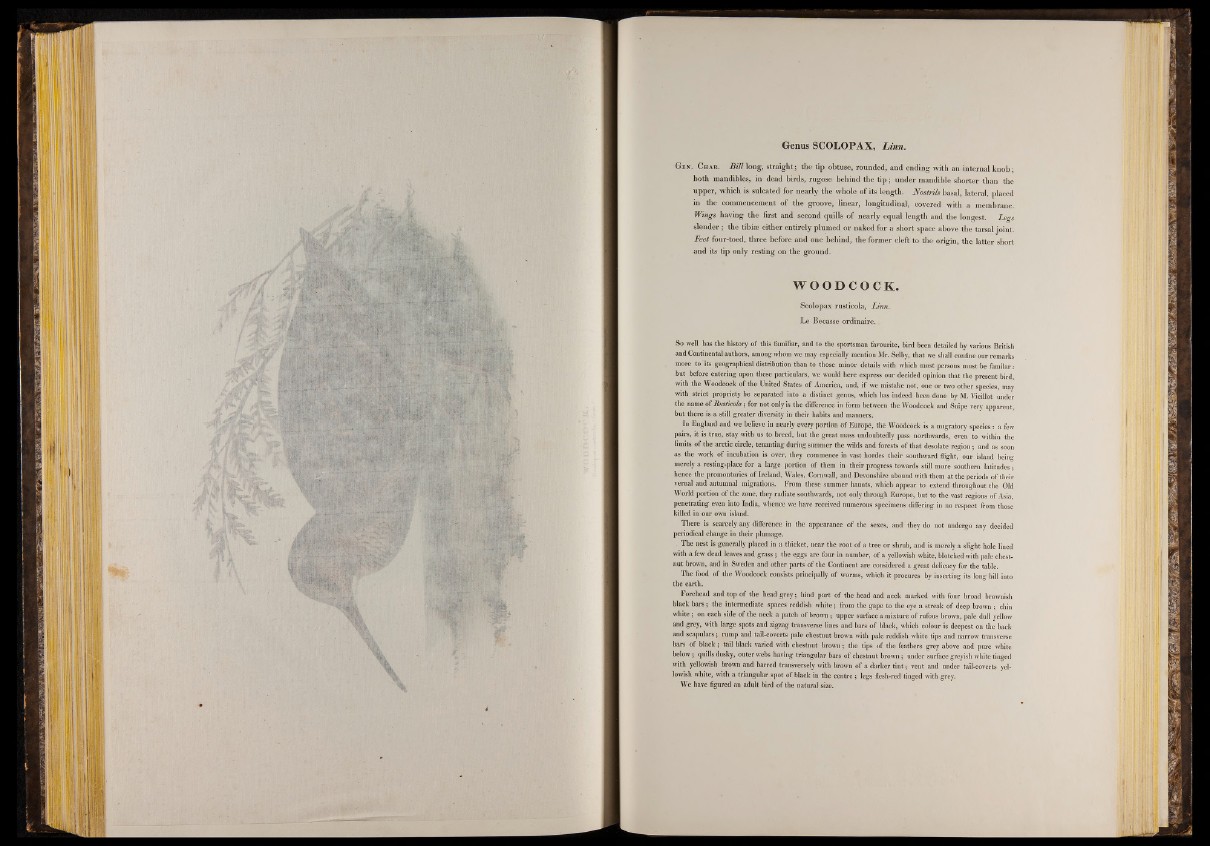
Genus SCOLOPAX, Linn.
Gen. Char. B ill long, straight; the tip obtuse, rounded, and ending with an internal knob •
both mandibles, in dead birds, rugose behind the tip ; under mandible shorter than the
upper, which is sulcated for nearly the whole of its length. Nostrils basal, lateral, placed
in the commencement of the groove, linear, longitudinal, covered with a membrane.
Wings having the first and second quills of nearly equal length and the longest. Legs
slender; the tibiae either entirely plumed or naked for a short space above the tarsal joint.
Feet four-toed, three before and one behind, the former cleft to the origin, the latter short
and its tip only resting on the ground.
WOODCOCK .
Scolopax rusticóla, Linn.
Le Becasse ordinaire.
So well has the history of this familiar, and to the sportsman favourite, bird been detailed by various British
and Continental authors, among whom we may especially mention Mr. Selby, that we shall confine our remarks
more to its geographical distribution than to those minor details with which most persons must be familar:
but before entering upon these particulars, we would here express our decided opinion that the present bird,
with the Woodcock o f the United States o f America, and, i f we mistake not, one or two other species, may
with strict propriety be separated into a distinct genus, which has indeed been done by M. Vieillot under
the name o f Rusticóla; for not only is the difference in form between the Woodcock and Snipe very apparent,
but there is a still greater diversity in their habits and manners.
In England and we believe in nearly every portion o f Europe, the Woodcock is a migratory species: a few
pairs, it is true, stay with us to breed, but the great mass undoubtedly pass northwards, even to within the
limits o f the arctic circle, tenanting during summer the wilds and forests o f that desolate region; and as soon
as the work o f incubation is over, they commence in vast hordes their southward flight, our island being
merely a resting-place for a large portion o f them in their progress towards still more southern latitudes ;
hence the promontories o f Ireland, Wales, Cornwall, and Devonshire abound with them at the periods o f their
vernal and autumnal migrations. From these summer haunts, which appear to extend throughout the Old
World portion of the zone, they radiate southwards, not only through Europe, but to the vast regions o f Asia,
penetrating even into India, whence we have received numerous specimens differing in no respect from those
killed in our own island.
There is scarcely any difference in the appearance o f the sexes, and they do not undergo any decided
periodical change in their plumage.
The nest is generally placed in a thicket, near the root of a tree or shrub, and is merely a slight hole lined
with a few dead leaves and grass ; the eggs are four in number, o f a yellowish white, blotched with pale chestnut
brown, and in Sweden and other parts o f the Continent are considered a great delicacy for the table.
The food of the Woodcock consists principally o f worms, which it procures by inserting its long bill into
the earth.
Forehead and top of the head g re y ; hind part o f the head and neck marked with four broad brownish
black bars; the intermediate spaces reddish white; from the gape to the eye a streak o f deep brown ; chin
white; on each side o f the neck a patch o f brown; upper surface a mixture of rufous brown, pale dull yellow
and grey, with large spots and zigzag transverse lines and bars o f black, which colour is deepest on the back
and scapulars; rump and tail-coverts pale chestnut brown with pale reddish white tips and narrow transverse
bars o f black ; tail black varied with chestnut brown; the tips o f the feathers grey above and pure white
below; quills dusky, outer webs having triangular bars o f chestnut brown; under surface greyish white tinged
with yellowish brown and barred transversely with brown o f a darker tint; vent and under tail-coverts yellowish
white, with- a triangular spot of black in the centre ; legs flesh-red tinged with grey.
We have figured an adult bird o f the natural size.